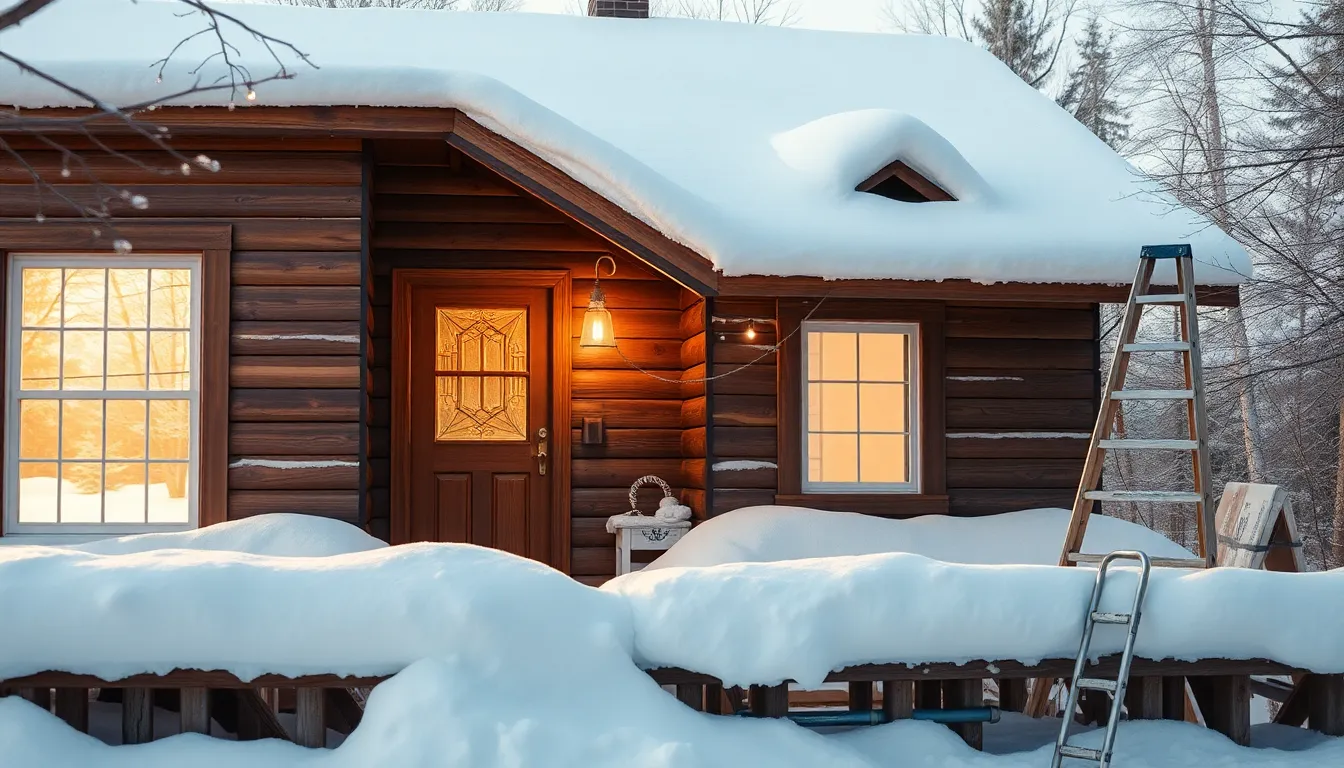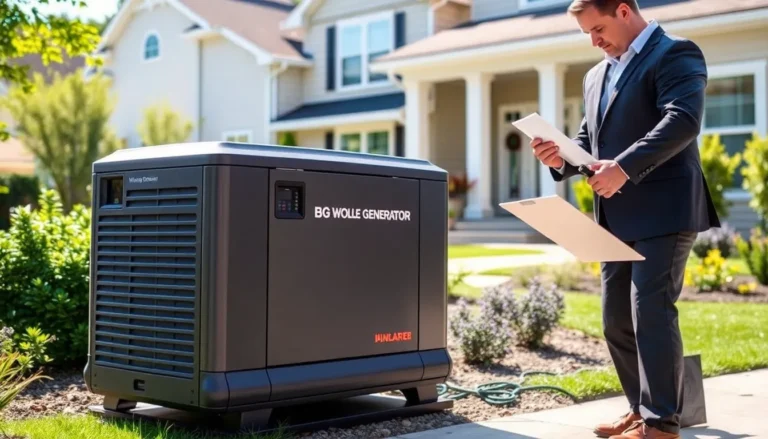As the leaves start to fall and the temperature dips, it’s time to face the frosty truth: winter is coming. While some might dream of cozy fires and hot cocoa, others dread the thought of skyrocketing heating bills and unexpected plumbing disasters. But fear not! Winterizing your home doesn’t have to feel like a chore—it can be a fun adventure.
Imagine transforming your home into a warm fortress against the winter chill, where you can sip your favorite drink without worrying about icicles forming inside your living room. With a little preparation and a dash of humor, you can tackle those winter woes head-on. So grab your favorite sweater, and let’s dive into the essential steps to ensure your home is ready to embrace the season, keeping you snug, safe, and maybe even a little smug about your winter readiness.
Table of Contents
ToggleImportance of Winterizing Your Home
Winterization protects a home from harsh weather. Homeowners save on energy costs when they enhance insulation and seal windows effectively. Properly winterizing prevents costly repairs related to water damage or frozen pipes.
Increased comfort during colder months results from thorough preparations, making indoor spaces more inviting. It’s critical to check heating systems and ensure they function efficiently before winter arrives.
Security measures, such as clearing gutters, help prevent ice dam formation, which can lead to roof leaks. Attending to outdoor fixtures, like hoses and faucets, reduces the risk of freezing.
Financial benefits stem from increased efficiency in energy use and fewer emergency repairs. Long-term savings often surpass initial winterization costs, making it a wise investment.
Enhanced safety accompanies proper winter preparation, minimizing risks associated with snow and ice accumulation. When pathways and entryways are accessible and safe, the chances of slipping and falling decrease significantly.
Winterizing fosters peace of mind for homeowners. Knowing the home is ready for winter allows families to focus on enjoying the season. This proactive approach ensures homes remain cozy, secure, and efficient throughout the winter months.
Key Areas to Focus On

Winterizing a home requires attention to several key areas. Focusing on insulation and sealing can significantly enhance comfort and energy efficiency.
Insulation
Proper insulation keeps heat inside and reduces energy bills. Attic insulation often serves as the first line of defense against winter chill. Checking basement and crawl space insulation also helps prevent heat loss. A well-insulated home maintains a stable indoor temperature, promoting comfort during frigid months. Using insulation materials like fiberglass, spray foam, or cellulose ensures effective thermal resistance. Experts recommend achieving an R-value of at least 38 for attic insulation to optimize energy efficiency. The investment in high-quality insulation pays off, often leading to lower heating costs over time.
Windows and Doors
Sealing windows and doors prevents drafts and heat escape. Weather stripping around doors serves as an effective barrier against cold air. Employing caulking on window frames minimizes gaps that allow cold air in. It’s beneficial to assess the condition of existing seals before winter starts. Installing storm windows provides an additional layer of protection and can improve energy efficiency. Energy-efficient windows, like double or triple-glazed options, offer substantial long-term savings. Homeowners often notice a significant difference in indoor comfort when windows and doors are properly sealed.
Heating System Preparation
Preparing the heating system is essential for ensuring a warm and efficient home during winter. Proper maintenance and adjustments can lead to significant savings and comfort.
Furnace Maintenance
Furnace maintenance tops the list of winter preparation tasks. Homeowners must clean or replace filters monthly for optimal airflow. A clean filter improves efficiency and extends the furnace’s lifespan. Scheduling a professional inspection is equally important. Technicians can identify and address potential issues, ensuring the system operates safely. Burning fuel efficiently reduces bills and enhances comfort. Checking for gas leaks, if using a gas furnace, also ensures safety. Lastly, clearing the area around the furnace promotes air circulation and reduces fire hazards.
Thermostat Adjustments
Adjusting the thermostat is a simple yet effective winterizing step. Setting the thermostat to a lower temperature when away can save energy. Smart thermostats offer programming options to automate these adjustments, providing convenience and savings. Homeowners should consider a consistent temperature at night for better sleep while maintaining heat efficiency. Also, checking the thermostat’s accuracy guarantees the home reaches desired temperatures without overworking the system. Regularly recalibrating the thermostat ensures accuracy, reducing unnecessary heating costs. Each adjustment contributes to a more comfortable and energy-efficient winter.
Addressing Exterior Concerns
Preparing a home’s exterior for winter helps prevent damage and enhances safety. These specific areas require attention to ensure a secure and efficient transition into the colder months.
Roof and Gutters
Inspecting the roof before winter is critical. Look for loose shingles and any signs of damage, as replacement can prevent leaks. Clearing gutters is essential to avoid ice dams, which can cause water to back up under shingles. Ensuring gutters and downspouts are free from debris allows proper drainage, reducing the risk of roof damage. Additionally, homeowners may consider adding gutter guards to minimize future blockages and ease winter maintenance.
Outdoor Plumbing
Outdoor plumbing demands special care as temperatures drop. Disconnect and drain garden hoses to prevent frozen water inside pipes, which leads to burst lines. Insulating exposed pipes using foam pipe insulation offers extra protection against freezing. Homeowners might also consider shutting off water to outdoor faucets, ensuring they’re properly drained. For added security, installing frost-proof outdoor faucets proves effective in avoiding winter plumbing issues.
Indoor Winterization Tips
Preparing the home for indoor winterization involves addressing key areas such as humidity control and emergency supplies.
Humidity Control
Maintaining optimal humidity levels in winter keeps indoor air comfortable. Aim for a relative humidity of 30 to 50 percent. Use humidifiers to add moisture, especially in heated spaces. Monitor levels with a hygrometer to prevent dryness, which can lead to health issues and damage wood furniture. Ventilation plays a crucial role; ensure bathroom and kitchen exhaust fans are functioning properly to reduce excess moisture. Additionally, sealing drafts can stabilize humidity by preventing the entrance of cold, dry air.
Emergency Supplies
Stocking up on emergency supplies provides peace of mind during winter. Essential items include non-perishable food, water, batteries, and flashlights. At a minimum, keep a three-day supply of food per person on hand. First aid kits should include basic medical supplies like bandages and antiseptics. Blankets, warm clothing, and a portable phone charger are also important to ensure safety during power outages. Regularly check and refresh supplies to maintain readiness for unexpected winter events.
Preparing a home for winter is more than just a task; it’s an opportunity to enhance comfort and security. By taking proactive steps to insulate, seal, and maintain heating systems, homeowners can enjoy a cozy environment while saving on energy costs. Addressing outdoor concerns and stocking up on emergency supplies further ensures safety throughout the season.
Embracing the winterization process fosters a sense of accomplishment and readiness. Families can then focus on making the most of winter’s joys rather than worrying about potential issues. With the right preparations in place, winter can become a time of warmth and togetherness.


